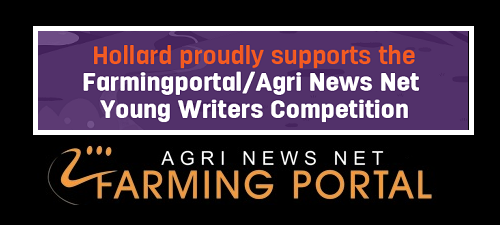Hollard Insure and Farmingportal.co.za and Agri News Net - Young Agri Writers competition- Rest of the winners ( In no specific order)
Backgrounding is a period between the weaning of calves and placing them on the feedlot. During this period the calves are subjected to moderate growth rates at low cost. The main objective of backgrounding is frame building – in other words, increasing the skeletal size of the calf. Calves may also receive health preconditioning protocols during this time.
Several beef producers are known to conduct backgrounding, including cow-calf producers, specialised backgrounding producers and feedlot producers. Not all producers have the same facilities with some beef producers unable to background while some background their calves in drylots and others on pasture. Drylot backgrounding is more intensive and stressful with the advantages of higher weight gains and calves adjusting to bunk feeding. Pasture backgrounding on the other hand is less stressful due to a smaller dietary change, less environmental change and less dust and mud in the kraal. In South Africa, the most common type of backgrounding is pasture backgrounding. Three broad categories of pasture backgrounding can be identified, namely: green/cultivated pastures, crop residues and natural veld. Among South African producers, natural veld is the most prevalent backgrounding system.
Various benefits are offered through backgrounding. Backgrounding serves as a market-outlet for forages, a grouping method of small packages of animals into larger and more manageable loads, an absorption system for animals not feedlot-ready, a value-adding programme to add weight to light calves and sell them at heavier weights and revenues given the same weaner price and a manipulation method of both the timing and the quantity of feedlot cattle placement. Desired growth rates can be realised during this period. This period also offers calves a time to adjust before being placed on feedlot due to a less stressful environment which is conducive to improved health, productivity and ultimate feedlot performance. Feedlot performance is an excellent indicator of the positive influence backgrounding has on an animal. Backgrounded animals are known to show the following improved feedlot performance: shorter feeding periods, greater daily weight gains, fewer morbidities and mortalities, little or no carcass composition changes and heavier carcass weights. Even though the total period, which includes backgrounding and feedlotting, is longer with backgrounding, producers have frequently found that the whole process is at a lower cost to the feedlot producer.
Disadvantages are however also associated with backgrounding. As backgrounding is conducted by various divergent producers, there is no consistent guideline of exactly how to background calves. One of the major variations among backgrounding producers is which weight classes are backgrounded. Another variation is the duration that producers subject their animals to backgrounding. This poses the challenge to first establish exactly which weight classes should be backgrounded and secondly determine for how long the respective weight classes backgrounded. An additional disadvantage relevant to pasture backgrounding is the vulnerability to rainfall variation. As rainfall varies, the pasture’s ability to sustain a certain amount of animals varies. Rainfall variations below the average can be overcome with supplemental feeding, although supplementation might rapidly make backgrounding very expensive.
Economics should always be considered regardless of how advantageous any strategy appears in terms of production performance. Considerations should be made regarding physical costs and prices as well as opportunity costs. Weaner prices are discounted if the weaners are too light or too heavy. Some producers buy light calves and sell them later at the same price for a greater revenue due to heavier weights. If weaner prices, in general, are very high, it will be challenging to make a sufficient return on the input cost. Feed prices dictate whether backgrounding or feedlotting will be the most profitable. Given higher feed prices, backgrounding will be preferred since less feed is required. Carcass prices cannot be altered by producers. To increase revenue, the carcass should be heavier, which is possible through backgrounding. The opportunity cost of land refers to whether or not it would have been more profitable to use the backgrounding land parcel to rather increase the capacity of a current business enterprise, launch a different enterprise or perhaps to lease the land. The opportunity cost of temporal changes is the cost of the altered duration of feeding cycles, different amounts of cycles per year as well as the timing of sales.
In conclusion, backgrounding is conducted with the aim of frame building in weaned calves which lead to heavier animal weights and carcasses. Moderate growth rates at a low cost are maintained. Market prices should be kept in mind to determine the economic benefit in a specific scenario.
Chéri-Lynn Steyn















